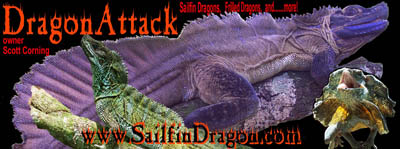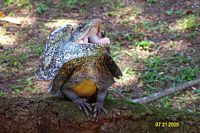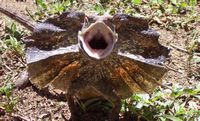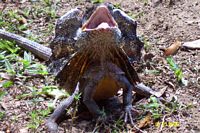I am no longer working with Frilled Dragons but have left the info up!
General Information and Husbandry Techniques
Frilled dragons(Chlamydosaurus kingii), also known as "frillies", "frilled lizards" or "frill-neck lizards"are easily described to a non- reptile enthusiast as the dinosaurs in Jurassic Park with the necks that frill out. Almost anyone with an interest in animals recognizes a Frilled Dragon, a beautiful lizard with a large colorful appendage that can erect itself around the neck to warn away predators and defend territories. Their ability to run bipedally is also quite entertaining. These large Agamids make excellent captives and are very popular among reptile keepers looking to expand their collection beyond some of the more common starter species. Within the pet trade we have 2 types of Frilled Dragons, the New Guinea and the Australian which are both the same species, but different ranges have created great variances in the process of evolution. Generally the New Guineas, "NG" frilleds are much easier to obtain, being that many have been wild caught and or farm raised in Indonesia and exported. The NG frillies generally are smaller than their Aussie mates and typically are a marbled grey coloration with sometimes a hint of brown. The Aussies on the other hand have quite a bit of variation depending on locale, and the Northern Territory Reds are highly sought after, having a much overall brick red hue. There are silver variations from the Queensland area too, closer to the coloration of the NG's but reaching larger proportions. People have used the white cheeks as an indicator for the Australian frilleds, this isn't always an indicator, but may allow some accuracy when purchasing a larger frilled dragon that has these white patches at each corner of the mouth. Many of the variations have been crossbred in captivity creating much confusion, so buyer beware! I highly recommend purchasing if possible, well started "true captive born" hatchlings from an experienced breeder. Many sellers say they are captive born, when in actuality are farm bred imports. The imports can be a bit tricky, with disease and post-dehydration issues kicking in a month or 2 after purchase.
Caring for your Frilled Dragon
Keeping healthy frilled lizards is relatively quite easy as these lizards are generally very complacent and have similar dispositions in general to that of a bearded dragon, although husbandry is rather different. A much taller than longer cage is recommended. For juveniles this isn't as important and can be raised in aquariums or tubs with sufficient vertical, diagonal, and horizontal branches. Lighting is pretty much the same as with the other lizards mentioned in this website. A good heat light, preferrably a spotlight that can get the basking area 120F plus is a good idea, a daytime ambient cage temp of around 90F and a good UVB source will help keep your lizard in great condition. If you can generally follow many of the tips i have included in the care of Sailfin Dragons, you will be on the right track with many of the lizard species. Juveniles are thirsty little buggers and i recommend misting them morning and evening so that they can drink and hydrate properly, also supply a small shallow water dish they can easily crawl into. Again as mentioned before in this website, do not assume that supplying a water dish is gonna do the trick for hydrating your tropical lizard, they very much depend on you for supplying a humid environment with an induced rain cycle to stimulate drinking, a water drip system and or fogger can also be experimented with. For larger Frillies, i too mist twice a day and have a larger water pan available for soaking, hydrating, and defecating. These lizards are much cleaner than most larger lizards i've kept, they just don't seem to create a huge mess. I recommend keeping them on a humid substrate, reptile bark, cypress mulch, coco fiber(coir), or natural dirt floor.
Frillies will spend most of their adult lives clinging on to vertical tree trunks, and this is where a taller cage will help give them the needed vertical space to live a healthier life.
Feeding
Frilled Dragons are for the most part omnivorous minus the plant matter. I don't believe they eat much plant matter in the wild, maybe as some sort of remedy for stomach upset, but usually have to be tricked in captivity to eat any fruits or veggies. Anyways, if you have a dragon that takes plant matter great, it will just be more food items to round out their diet. Their DIET consists mainly of arthropods, and most insects and spiders are taken very happily. Of course in captivity, we have access to crickets, and all sizes of frilleds relish crickets, this is a good main diet along with roaches and caterpillars such as hornworms. Superworms are a great treat with an excellent array of amino acids, but should not be fed as a main meal consistently, you will notice the high fat content of superworms along with chitin(the outer shell) will cause your dragon to become lazy, eat less often, and decide to hold off until the next time superworms are offered(they must taste better than crickets). Im sure this goes with all the other fat filled larva, such as waxworms and butterworms. Caterpillars on the other hand, such as the giant hornworms, silkworms, or leaf rollers can make a great nutritious meal. Make sure you are feeding non-toxic non stinging prey items! Rodents small enough to be eaten are a great addition to the diet. I'd rather feed small hopper mice than pinkie mice, since pinkies have more fat and less bone/calcium. The occasional pinkie can be a treat, just like superworms. Baby to juvenile Frillies should be fed morning and evening to ensure proper growth. Make sure you use a good Calcium with vitamin D3 supplement on your feedings, and once or twice a week a good reptile vitamin. I highly recommend RepCal calcium indoor fine ground, and their Herptivite for vitamins. Adults can be fed every other day. You can feed them in a bowl, I pour a bunch of supplemented crickets in a bowl, and the Frillies come off their branches to munch out. Grasshoppers, Locusts, and Katydids, make a fine food for Frillies, once again make sure you are not feeding any known toxic types, such as Lubber grasshoppers. There are also canned grasshoppers available these days for the reptile trade, luckily for us, people eat them in Thailand and the reptile trade has caught on to offer these wonderful delicacies........personally i would'nt know how wonderful they really are though. If feeding roaches, either freeze them and put them in their bowl after they've thawed out, or if feeding live, use tongs and hand feed them on their branches, this will help prevent any escapee roaches...... your non-reptilian friends will have nothing to scream about, and may come back over for a second visit, or not.



